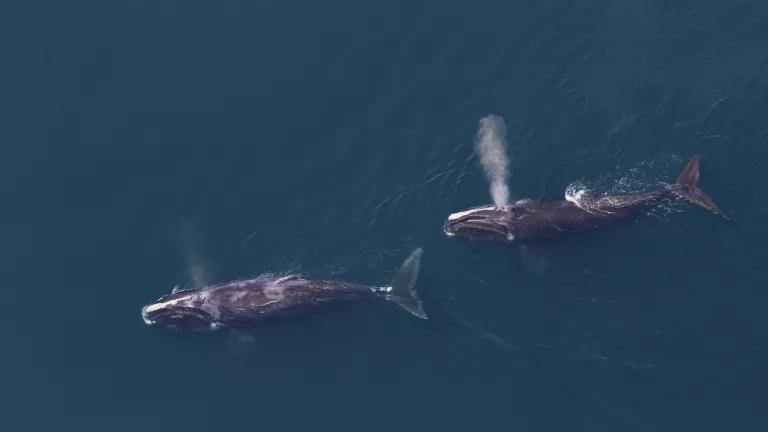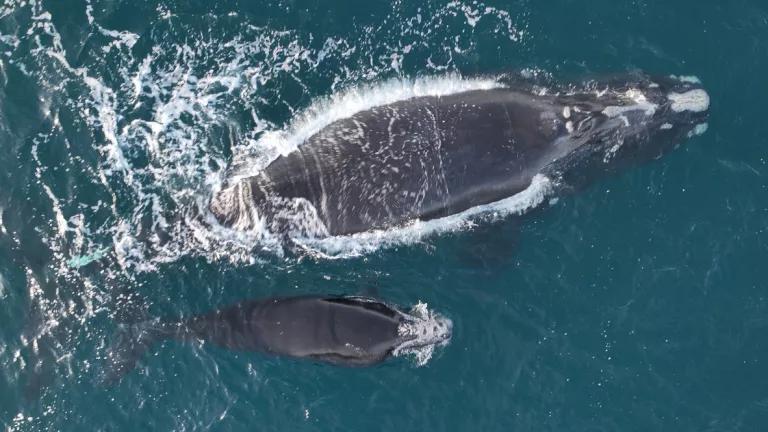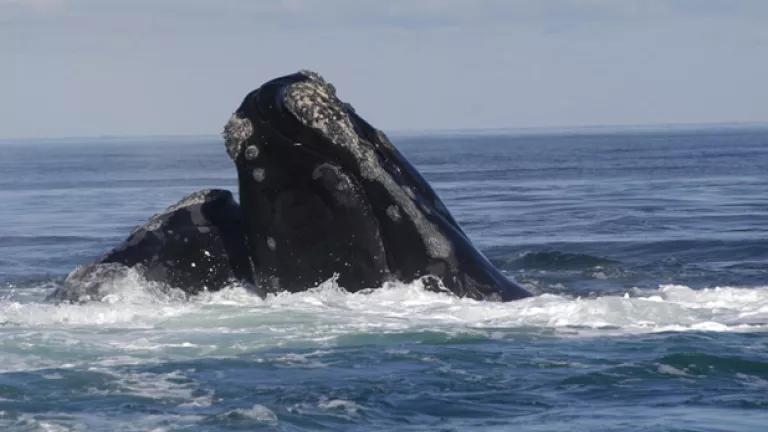
New vessel strike reduction measures proposed by the National Marine Fisheries Service would improve protections for right whales.
New proposed regulations issued by the National Marine Fisheries Service (NMFS) would significantly strengthen existing vessel speed requirements and meaningfully reduce vessel strike risk for North Atlantic right whales—a necessary move to save the species from extinction. TAKE ACTION.
North Atlantic right whales are critically endangered and declining rapidly. Fewer than 340 individuals remain, and even one human-caused fatality per year will push the species closer to extinction. The risk of even a single lethal vessel strike is unacceptable, yet current numbers far exceed that level. One of the most effective ways to reduce the risk of a lethal vessel strike is to slow vessels down to speeds of 10 knots or less.
In the new proposed rule, NMFS has determined that three major changes to current requirements are necessary to help stabilize the right whale’s decline from vessel strikes and promote long-term recovery of the species:
- Expanding Seasonal Speed Zone (previously named Seasonal Management Area) boundaries and timing to better capture areas and months with elevated vessel strike risk. As shown in the map below, the proposed expansions are significant and cover a large portion of the continental shelf.
- Requiring most vessels greater than or equal to 35 ft in length to transit at 10-knots or less within active Seasonal Speed Zones. This greatly increases the number of vessels required to slow down compared to current requirements that only target vessels 65 feet or greater in length.
- Implementing a new Dynamic Speed Zone framework to provide mandatory vessel speed reductions where and when they are needed. Previous dynamic slow downs were voluntary and found to only be observed by a relatively small number of vessels.
The proposed changes are also expected to provide ancillary benefits, including a reduction in vessel strikes involving other protected large whale species and a decrease in harmful vessel air emissions. Based on the assumption that vessel noise levels generally decrease at reduced speeds, NMFS also anticipates the proposed measures to have short and long-term moderate beneficial impacts on ocean noise levels. Reduced noise from vessels will have positive overall effects on ecosystem health.

Areas where vessels would be required to travel at speeds of 10-knots or less have been greatly expanded and would apply to almost all vessels 35-feet and greater in length.
The proposed changes are a strong improvement over existing protections for North Atlantic right whales from vessel strikes. We recommend NMFS also incorporate the following two measures into the Final Rule to maximize risk reduction:
- Implement a year-round vessel Speed Zone in the waters off of Southern New England, which are an increasingly important year-round foraging habitat for North Atlantic right whales.
- Trigger Dynamic Speed Zones upon the confirmed visual detection of a single North Atlantic right whale, to better protect reproductive females and mother calf pairs. The current rule requires confirmed visual detection of at least three right whales, which is too high of a bar for a critically endangered species where every whale matters.
North Atlantic right whales are especially vulnerable to vessel strikes due to their coastal distribution and preference to occupy waters just below the surface. This is particularly true for mothers and calves, and females, calves, and juveniles have been disproportionately impacted by vessel strike. Three calves are known to have been killed or fatality wounded by vessel strikes since 2020 alone, and one of the calves' mothers, a whale known as Infinity, was seriously injured at the same time.
Publication of the final rule should be timed to go into effect before the start of the calving season on November 15, and any delays should trigger NMFS’s issuance of emergency regulations to implement the rule and the recommended changes to protect pregnant females, and mothers and calves.

Mothers and calves are particularly vulnerable to vessel strike. This weeks old calf was struck and killed by a 54-ft sport fishing vessel in February 2021. It's mother, Infinity, was seriously injured at the same time.
Even with the proposed changes to the vessel speed rule and our additional recommendations, risk of vessel strike to North Atlantic right whales will not be reduced to zero. We therefore ask NMFS, and its partner agencies such as the Bureau of Ocean Energy Management and the United States Coast Guard, to continue to pursue additional complementary measures, such as sector-specific vessel slow-downs, port incentive programs to encourage year-round speed reductions, and advancing near real-time monitoring programs and technologies to improve detections of whales out on the water.
The proposed rule is an excellent start, but it is still just the beginning of a long road to recovery for North Atlantic right whales. We cannot take the pressure off if the species is to survive. Reducing vessel strike risk alone will not be enough to reverse the decline of the species. NMFS must, in parallel, continue its work to significantly reduce the risk of entanglements, including by rapidly advancing ropeless fishing systems to commercial scale deployment, as well as other current or future stressors, including offshore energy development.




